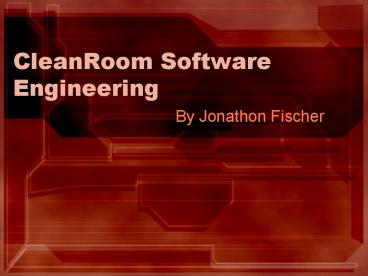CleanRoom Software Engineering PowerPoint PPT Presentation
1 / 25
Title: CleanRoom Software Engineering
1
CleanRoom Software Engineering
- By Jonathon Fischer
2
Overview
- What is Cleanroom SE
- The Cleanroom process
- Cleanroom results
3
What is CleanRoom SE?
- Created by IBM in the early 80s
- Named after cleanrooms used in Semiconductor
Industry
4
What is Cleanroom SE? (cont.)
- Iterative 14 step process
- Goal of 0 or near 0 errors
- All errors account for by compile time
- No Unit testing
- Developers dont compile the system.
5
4 teams of Cleanroom SE
- 4 teams
- Management
- Tracks progress and budget
- Specification
- Defines required functions and usage of system
- Development
- Creates the system
- Certification Team
- Tests the system against specifications
6
Cleanroom Flow
7
Project Planning Process
- Adapt process model to project
- Cleanroom Engineering Guide
- Create project Plan
- Software Development Plan
- Review Plan with customer and team members
8
Project Management Process
- Begins the Cleanroom process
- Defines incremental development and certification
- Measures for correctness testing defined
9
Project Improvement Process
- Find ways to improve performance and facilitate
changes - Create Performance Improvement Plan
- Made prior to a change
- Outline additional training for change
- Revise Cleanroom Engineering Guide
- Usually, changes started at milestones
10
Engineering Change Process
- Make changes to the product
- Faults or failures are found
- Must be compliant with the Configuration
Management Plan - Changes recorded in Engineering Change Log
- Change evaluated for correctness and impact
11
Architecture Specification Process
- Decomposes the project
- Requirements and Specifications must be partially
complete - Start at high level of abstraction and go lower
- Black box to Clear box
- Generate analysis models
12
Requirements Analysis Process
- Started immediately after work order is received
- Work with customers to determine
- What the system does
- How it will be used
- Preferred Environment
- Repeated each iteration or if requirements added
- Most stable requirements implemented first
13
Function Specification Process
- Determine unambiguous user scenarios regardless
of probability of occurrence - Recorded in Function Specification Doc
- Mathematically representation of reqs
- Each spec linked to at least 1 req
- Written in Black box style
14
Usage Specification Process
- Determine info about the users
- Type of user
- User environment
- Started when Functions Specifications is
partially complete. - Provides a way to effectively allocate resources
- Helps to complete and validate Function Specs.
15
Increment Planning Process
- Create/revise Increment Construction Plan
- Helps to determine
- Elements to complete immediately
- Elements to stub out and finish on a different
iteration - Using incrementation allows for mistakes to be
caught and fixed earlier.
16
Software Reengineering Process
- Used when incorporating reused software
- Prior to integration determine
- Reliability of software
- Benefits outweigh cost of integration
- Integration can be done
- As is
- With a wrapper for limited access
- Reengineered to better fit project
17
Incremental Design Process
- Implements Incremental Construction Plan
- Input code here!
- Multiple reviews
- Assess progress of current increment
- Determine changes to keep verification and
project maintainability - Goal few faults as possible before Correctness
Verification
18
Correctness Verification Process
- Verifies the program will work to specifications
without running the system - Uses proofs and mathematical methods for
verification - Program structures broken down to mathematic
equivalence - Correctness Verification is more effective and
efficient than Unit testing - Can accurately predict almost infinite number of
execution paths - Unit testing can only do so much
19
Usage Model and Test Planning Process
- Usage model created from refined specs
- Cover a broad range of modules
- Especially ones where failure is unacceptable
- Shows each state and transitions
- Create Incremental Test Plan
- Models and test Plan determine
- Test cases
- Testing environment
20
Statistical Testing and Certification Process
- Final phase for each increment
- Code is run for the first time.
- Tests are performed according to Incremental Test
Plan - Test results compared to function specs
- Each result used to determine measurement of
system for Certification - Failure gt return to Incremental Design
- Success gt proceed according to Increment
Construction Plan
21
First Cleanroom Project
- IBM 1988
- Program automatically restructured COBOL code
- Contained 33 KLOC
- In first 3 years of use
- 7 errors found
- All were easy fixes.
22
NASA and Cleanroom SE
- 1989 FORTRAN satellite controller
- 40 KLOC, only 4.5 errors / 1KLOC
- 40 increase in quality
- 80 increase In productivity
- 780 LOC per person month!!
- Ave. embedded system 40 160 LOC/pm
- Ave. commercial system 200 800 LOC/pm
23
Review
- 14 step iterative process
- Goal of 0 or near 0 errors
- No Unit testing
- Seems difficult, but can have amazing results
24
Questions ?
25
Sources
- Hausler, P. A., Linger, R. C. (1994).
Adopting Cleanroom Software Engineering With a
Phased Approach. IBM Systems Journal, Volume 33,
Issue 1, p89. EBSCOhost. - Linger, R. C., Trammell, C. J. (November 1996).
Cleanroom Software Engineering Reference Model,
Verison 1.0. found at - http//www.sei.cmu.edu/pub/documents/96.reports/p
df/tr022.96.pdf - Oshana, R. Quality Software Via a CleanRoom
Methodology. Embedded Systems Programming.
Found at http//www.embedded.com/97/feat9609.ht
m - Steward, Donald V. (1987). Software Engineering
with Systems Analysis and Design.Monterey, CA,
Brooks/Cole Publishing Company. - Uta.edu. Cleanroom Sotware Engineering. Found
at http//www.uta.edu/cse/levine/fall99/cse5324
/cr/clean/page.html

